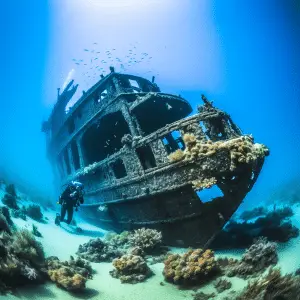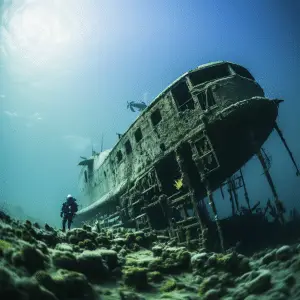Introduction to Wreck Diving
Dive into the depths of the ocean and be transported back in time! Wreck diving in the Philippines is an unforgettable adventure. From all over the world, scuba-enthusiasts come to discover the diverse and beautiful sites.
Dive into Coron Bay in Palawan and explore Japanese WWII shipwrecks. These vessels, now home to vibrant coral reefs and marine life, present a captivating and haunting atmosphere.
The Philippines offers something for every level of diver, with a variety of wrecks to explore – from small fishing boats to large cargo ships and even aircraft! Every wreck has its own story – like the USS New York, an American naval ship that sank off the coast of Subic Bay during WWII. Personal belongings, cannons and ammunition boxes still lay silently beneath the waves. A humbling experience!
Wreck Diving Spots in the Philippines

Dive into the captivating world of wreck diving in the Philippines! Explore sunken ships, uncover their stories beneath the sea. This rich maritime nation has several amazing wreck sites to discover.
Like Coron Bay – the “Wreck Diving Capital” of the Philippines. It’s home to WWII Japanese shipwrecks that are now havens for marine life. Or Batangas and Anilao, where you’ll find submerged aircraft and cargo vessels. Plus, Dumaguete on Negros Island, with its coral-encrusted wrecks, galleons and war warships from the past.
Tubbataha Reefs Natural Park is a must-see! It’s a UNESCO World Heritage Site with spectacular coral reefs, and two famous wrecks – the Seacow and USS New York.
To make your dive the best experience possible, pick a reputable dive operator who values safety and conservation. Take advanced courses tailored for wreck diving, to give you more confidence underwater. Remember, these sites are delicate ecosystems. Don’t touch or damage the marine life or artifacts.
The Philippines is an incredible place for wreck diving. Immerse yourself in history, and come away with memories that’ll last a lifetime. Put on your wetsuit and dive into a sunken treasure chest of mysterious history and the occasional lost flip-flop!
Wreck Diving Equipment and Preparation
Wreck diving is an exciting activity that needs the correct gear and preparation. To make the most of this adventure, divers must guarantee they’ve got the right stuff and know-how.
Scuba Gear
Divers should have the general scuba gear like a wetsuit or drysuit, fins, mask, regulator, and buoyancy control device (BCD). It’s vital to pick dependable equipment that fits well for maximum comfort and safety.
Dive Lights
Exploring wrecks usually means going into dark places where natural light can’t reach. Dive lights are critical for brightening the area and permitting divers to see clear.
Underwater Navigation Devices
Navigating through a wreck can be difficult due to complex structures and limited visibility. Divers should bring devices such as compasses and reels to help with navigation and avoid getting lost within the wreck.
Proper Training
Before attempting wreck diving, divers should undertake specialised training. This includes learning about potential hazards, the proper methods for entering and leaving wrecks, and how to handle emergency circumstances that may come up.
Besides these fundamental equipment requirements, there are some unique details worth mentioning. For instance, it’s vital for divers to be fit as wrecks can present testing environments needing energy and strength.
To improve the complete experience of wreck diving, think about the following ideas:
- Buddy System: Always dive with a buddy when exploring wrecks. Having someone by your side provides an extra layer of safety plus allows for shared experiences.
- Research: Carry out thorough research on the wreck you plan to explore. Knowing its history can add depth to your adventure and increase your appreciation of the underwater environment.
- Maintenance: Regularly inspect and maintain your diving equipment to make sure it works correctly when wanted most. Correct care prolongs the life of your gear and contributes to your safety underwater.
- Pre-Dive Briefing: Before each dive, have a thorough pre-dive briefing with your dive buddy and instructor. Discuss the dive plan, potential hazards, emergency procedures, and signals to guarantee a smooth and enjoyable experience.
By adhering to these tips and being well-prepared with the right equipment, divers can safely investigate remarkable wreck sites while immersing themselves in the rich history found beneath the waves. Remember, safety first: it’s a wreck dive, not a wreck demise!
Safety Measures and Guidelines for Wreck Diving
Ready for a thrilling adventure? Wreck diving is the perfect choice for experienced divers! To make sure your experience is both safe and enjoyable, it’s important to follow proper safety procedures.
- Equipment: Use only reliable, well-maintained diving gear. Check everything before each dive to make sure it’s in working order.
- Training: Get certified for wreck diving. This will give you the knowledge and skills to navigate hazardous places.
- Buddy System: Never dive alone. Have a dive buddy with you at all times. Stay close and communicate underwater.
Remember to respect the historical significance of the wreck site. Don’t take artifacts or damage anything – it may be protected by law.
Other tips:
- Plan Your Dive: Research the wreck you’re exploring and familiarize yourself with its layout.
- Maintain Buoyancy Control: Wrecks often have tight spaces and fragile structures. So, maintain good buoyancy control to avoid entanglement or damage.
- Stay Within Limits: Don’t push your limits. Only attempt dives you are comfortable with and qualified for.
By following these safety measures and suggestions, you can make the most of your wreck diving experience while preserving these historical sites for future generations.
Wreck Diving Certification and Training
Wreck diving is an exciting experience, but it also requires proper certification and training to do safely. To take part in this thrilling adventure, one must become an Advanced Open Water Diver. This is a 2-4 day specialty course that teaches navigation in complex wreck structures, penetration techniques for inner sections, and safety protocols.
Those who want to explore deeper, more challenging wrecks can become Technical Wreck Divers, which requires additional training. Cave Divers are certified at an expert level to explore underwater caves with restricted passages.
A group of certified wreck divers had a memorable experience in Coron, Philippines. They swam through the decaying corridors and discovered hidden treasures, like old cannons and anchors. This journey was both eerie and exhilarating.
Certification gives divers the knowledge and confidence to explore these unique underwater landscapes. So take the plunge into this extraordinary realm where history meets adventure!
Wreck Diving Experience and Tips
Wreck diving is an electrifying and rare experience that lets divers explore sunken ships, planes, and other underwater structures. Here are a few must-know tips for a successful and safe wreck dive:
- Plan well: Before taking the plunge, research the wreck you’ll explore. Get info on its depth, visibility, currents, and possible dangers. This helps you to be prepared and get the most out of your dive.
- Get the right gear: Specialized equipment is necessary for wreck diving. You’ll need a reel or line for navigation, a strong flashlight for inside the wreck, and gloves and knives for safety.
- Good buoyancy control: Great buoyancy control is key to prevent harm to delicate marine life or reducing visibility by stirring up sediment. Practice finning techniques to lessen water disturbances.
- Stay in your level: Wreck diving can be tough even for experienced divers. Make sure you have the right certifications and training before attempting any wreck dives beyond your skills. Start with shallower wrecks then move on to more advanced ones.
- Respect the environment: When exploring, don’t remove artifacts or disturb the site. Take pictures, leave bubbles. These structures are historical artifacts and ecosystems.
Also, follow dive operators’ instructions when wreck diving.
By the way, did you know that the Philippines is one of the world’s best wreck diving spots? The Subic Bay wrecks offer a glimpse into WWII, with several sunken warships for daring divers to explore.
Conservation Efforts and Environmental Impact

Dive into the realm of wreck diving in the Philippines – conservation efforts and environmental impact are key! Three vital components help preserve the marine environment and allow divers to explore fascinating wrecks: marine sanctuaries, artificial reefs, and sustainable tourism.
Moreover, it’s important to understand the rich history of wrecks in the Philippines. Sunken ships from World War II serve as a reminder of past conflicts. Exploring these wrecks gives a thrilling experience, honoring the memories of those who fought. By understanding the historical significance, we can appreciate the importance of preserving these sites to future generations. So, dive in and experience the exciting and haunting adventure of wreck diving in the Philippines!
Conclusion: Exploring the Underwater Wonders of Wreck Diving in the Philippines
Diving into wrecks in the Philippines is a captivating experience. Discover an underwater world of wonder with sunken vessels from World War II to 19th-century Spanish galleons! Descend and be transported back in time. See colorful coral and vibrant marine life.
One special wreck is the SS Panay. An American gunboat that sank during WWII. Now an artificial reef, it’s full of marine species. Swim through its dark corridors and vast cargo holds. Feel the power of nature.
Another wreck is the San Ignacio de Loyola. A Spanish galleon that met its fate in the 1600s. Its remnants are on the sea floor. Explore for a glimpse into history and uncover hidden treasures!
For wreck diving, get proper training and certification. Choose dive operators who prioritize safety and conservation. Bring an underwater camera to capture memories of unique encounters with marine life. Enjoy the breathtaking sights!
